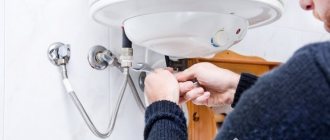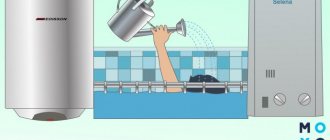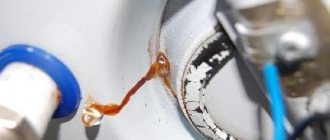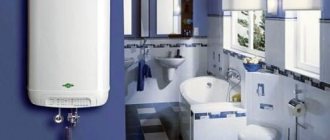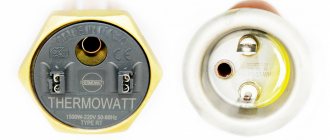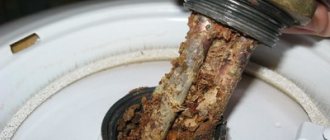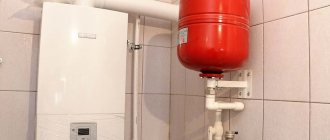In this article I am going to tell you how a boiler differs from a water heater in terms of design and consumer characteristics. In no case do I want to make any final verdict on the advantages of one or another solution: the purpose of writing this article is to explain to a potential buyer the key features of both devices and to share my own experience of using them.
Boiler in the bathroom on the first floor of my house.
First meeting
First let's look at the definitions:
- A boiler , or storage water heater, is a thermally insulated tank with a heating element. The latter is played by a heating element, gas burner or heat exchanger connected to the heating system and boiler (the so-called indirect heating boiler);
- An instantaneous water heater is a heat exchanger that heats water as it flows. The water tank inside the water heater is a very small container, the only function of which is to ensure water contact with the maximum area of the heat exchanger and prevent its overheating.
Flow-through heater in the attic bathroom.
A tank with a heat exchanger inside the device.
Together, a massive boiler and a compact flow-through device resemble characters from a famous cartoon.
Do you recognize?
So: the main difference between a water heater and a boiler is that the first heats water as it is consumed, and the second creates a supply of water heated to the desired temperature.
Features of a storage boiler
A storage boiler is usually considered a more convenient format for heating water than an instantaneous water heater. Its volumes differ significantly from the latter, due to the principle of operation. Water flows into a tank with a volume of 30 liters to 100 liters, depending on the capacity of the container. Inside the container there is a heating element that increases the temperature of the liquid.
The device is connected to the water supply system. After filling the tank, the liquid is heated to a certain temperature, which can be set on the thermostat. Some time after turning on the heating element, the liquid in the tank warms up evenly and the heating element stops working. This feature eliminates the possibility of system breakdown if the user forgets to turn off the device from the network. The storage water heater option is considered the most common for modern apartments and houses, but in order to evaluate the possibility of installing it, as in the case of a flow-through device, you will have to take into account the pros and cons of the system.
A storage type boiler can be represented by two heating systems:
Indirect. Water is heated using a heating element or gas boiler.
Indirect storage water heater
Straight. This device operates directly from the central water supply system.
Direct heating storage water heater
The classic shape of the boiler resembles an oval. But recently, stylish versions of a rectangle or cube have become popular.
Many boilers have two temperature heating modes. Moreover, low degrees are marked by the category of reducing energy costs. As a rule, the maximum heating temperature is 75–85 degrees, and the minimum parameters are 55. But experts do not advise using the latter mode often, as it promotes the proliferation of harmful bacteria and microorganisms.
Rectangular water heater on the bathroom wall
Load on the electrical network
The differences between a boiler and a water heater include, but are not limited to, significant differences in power consumption.
Flow heater
The minimum electrical power of the device is 3.5 kilowatts. Just such a device - Atmor Basic - is installed in my attic bathroom. The power consumption allows you to connect it to a regular European socket.
Attention: to avoid overheating, hidden wiring should be calculated based on a maximum current of 8 amperes per square millimeter of copper wire cross-section. If so, for a current of 16 amperes, corresponding to a consumption of 3.5 kW, you need wiring with a cross-section of at least 2 mm2.
A 3.5 kW appliance can be plugged into a wall outlet, but has strict wiring requirements.
The maximum power of commercially available electric flow heaters is 24 kW. They are connected only with a separate cable thrown from the panel, and only to networks with a voltage of 380 volts.
Gas appliances, for obvious reasons, are undemanding when it comes to wiring: the required power consumption is provided by the burner.
However, their operation requires compliance with certain safety measures:
- Installation is only possible in a room with its own ventilation duct;
- The device needs a constant flow of fresh air into the room where it is installed.
Boiler
The typical power of an electric boiler is from 1.3 to 2 kW.
The power of my boiler is 1.5 kilowatts.
It can be connected to any electrical outlet with a wire cross-section of 1.5 mm2. Connecting via an extension cord is not advisable, but is possible if absolutely necessary.
The photo shows a socket for connecting a boiler.
Connection diagram for an electric storage boiler to a heating system
When connecting a heating boiler to a heating system, several facts must be taken into account:
- A standard storage electric boiler does not have enough power to provide adequate heating.
- If the operation of an electric boiler is continuous, this will affect its service life.
- The heating system must have forced circulation of the coolant, this is due to the small cross-section of the inlet and outlet pipes of the boiler.
- The design of the boiler allows air to accumulate in the upper part of the tank, but this is unacceptable for a heating system.
Temperature stability
Which is better - a water heater or a boiler - in terms of output temperature stability? Agree that its fluctuations are quite unpleasant when trying to wash dishes and especially take a shower.
| Flow-through | Cumulative |
| With a fixed heating power, the temperature rises relative to the original by a fixed number of degrees. In winter and summer, the water temperature at the same pressure will differ by 10 - 20 C | The outlet water temperature is always constant. It is determined by the manually set position of the thermostat on the boiler body |
I noticed another unpleasant moment in the operation of the flow-through heater. In winter, the temperature of the water inside the water supply located within the heated room differs markedly from the temperature in the water supply main. As a result, after a few minutes of taking a shower, the water suddenly cools down.
Separately, it is worth mentioning the gas flow-through heater (gas water heater). In it, the water temperature is regulated automatically - a bimetallic or digital thermostat. The thermostat is activated when the outlet water temperature drops and increases the burner flame.
However, the rather low accuracy of adjustment and the large inertia of temperature changes make trying to take a shower a constant struggle with the lever or taps of the mixer. As the water pressure increases, the burner ignites and quickly heats the water to an uncomfortably high temperature; when reduced, the water cools just as quickly to ice cold.
Geyser.
What is an instantaneous water heater
An instantaneous water heater is a relatively new device designed to heat water. The principle of operation is to heat water as it flows. This allows you to ensure that there are no water limits and that you can use as much hot water as you need. An instantaneous water heater is called a column. It has different capacities, which are selected according to the number of users and the average hot water consumption per person. Speakers can be electric or gas. The type of energy carrier does not greatly affect the efficiency of use and heating rate. Electric modern designs are characterized by increased compactness. Classic geysers are large and pose some danger due to the need to work with an open source of gas. Both options are common and actively used at home.
Adjustment accuracy
In this parameter, the difference between a boiler and a water heater is that it allows you to set the target outlet temperature with maximum accuracy. The thermostat scale, as a rule, is devoid of graduation, but the trial and error method allows you to quickly select a comfortable temperature.
A flow-through heater, alas, cannot set a constant outlet temperature at all - simply due to the fact that by supplying constant power, you can heat the flow by a certain number of degrees. Following the inlet temperature, the outlet temperature will change.
No, you can still regulate it.
For this purpose they serve:
- Stepwise adjustment of heater power. In particular, Atmor Basic allows the use of power of 1.5, 2 and 3.5 kW;
Step power regulator.
However: power other than 3.5 kW is used only during the peak of the summer heat. In winter, 3.5 kilowatts is enough to heat the minimum flow of water to the minimum comfortable temperature.
- Manual pressure adjustment. The higher the flow, the lower the temperature.
heating element
The heating element in the boiler is conventional heating elements. They can be of two types:
submersible or wet
dry
It is optimal if the submersible heating element is made of copper. It is very resistant to corrosion.
And with timely care and proper operation, the service life of such a heating element can reach the service life of the water heater itself - at least 7-10 years!
The power of the heating element reaches 2.0-2.5 kW. The advantage of a submersible heating element is that it comes into direct contact with water, due to which it warms it up faster.
To heat a tank with a volume of 80-100 liters for a tubular heating element it will take more than 2 hours. However, in some cases, such heating elements are less practical.
If your water is hard and has additional impurities, this leads to scale formation. Which ultimately causes the boiler to fail.
Dry heating elements are made in the form of metal tubes coated with high-quality enamel, into which the heating elements themselves are installed.
The advantages of dry models are that they do not come into contact with water and scale does not accumulate on them. This allows you to operate the device for a longer time.
In addition, it does not make noise when heating water. Always try to choose models with two or more heating elements of different power. For example 1 and 1.5 kW.
As practice shows, if a failure occurs, it is usually only one heating element. At the same time, the second one continues to work and will allow you to continue using the boiler.
Replacing dry heating elements does not require draining the water, unlike submersible models.
Economical
Electric boilers are water heaters that are much less economical than instantaneous water heaters.
There are two reasons for this.
- Due to the limited power of instantaneous heaters, their creators have to limit the flow of water through the device. This, in particular, is achieved by using special shower heads and shower heads with a small clearance. Less water consumption means less energy consumption;
Standard watering can with reduced nozzle size.
- More importantly, the boiler periodically turns on the heat to compensate for heat loss through the insulation. A layer of polyurethane foam about 5 cm thick protects the tank from cooling quite reliably; however, from 1 to 3 kWh per day is still spent just on heating the atmosphere around the boiler.
Specifications
Electric boilers have the following characteristics, which are related to the power, the material used in the manufacture of factors related to control and safety.
Equipment power
The power of heating elements and their quantity affects the heating rate of the coolant. The average units have 2-3 elements, with a total power of up to 3 kW. They heat 150 liters of liquid in 3-4 hours. In some models, some elements can be turned off, which has a beneficial effect on savings.
Storage tank coating
The optimal, but more expensive solution is a coating based on stainless steel or titanium. The service life is calculated in decades, due to the fact that if the coating is damaged, the base is resistant to corrosion and destruction.
Enamel or porcelain glass coatings are cheaper, but less resistant to destruction. The service life is rarely longer than 3 years.
Characteristics
In order to increase the service life, the equipment is equipped with magnesium anodes. They reduce the acidity of the aquatic environment and make it less aggressive. Installed in titanium models, magnesium anodes do not need to be changed. In other cases, they require annual replacement.
Volume of the tank
The element is located inside, under the thermal insulation layer. The volume may vary over a wide range. It all depends on the model: from 10 to 450 liters. The optimal volume for use in a private home is about 150 liters.
Electromechanical component
For heating in houses, they use models designed for connection to a 200-240 V electrical network, with a current of up to 40 A, so when connecting, it is important to use wires of the appropriate cross-section and connect to the network through automatic machines
Price
At the time of purchase, the price of the heaters installed in my house was:
- Flow-through Atmor - about 2000 rubles;
- Storage Atlantic with a tank of 80 liters - about 6,000 rubles.
Prices have increased slightly since then, but the trend continues today: the boiler is noticeably more expensive.
In the upper price category there are combined boilers - water heaters with a tubular heat exchanger, which allows you to connect the device to the heating network as an indirect heating boiler, and a heating element to maintain the temperature at peak load or when the heating boiler is turned off. In this category, prices start from 27 - 30 thousand rubles.
Installation
In the simplest version, a flow-through heater with its own gander or shower can be easily connected with your own hands directly to the mixer, without altering the liner.
Connection instructions look like this:
- The faucet switches from gander to shower;
- The shower head is removed;
- The shower hose is connected to the heater inlet.
The nozzles have standard pipe thread size DN 15.
For a permanent installation of a flow-through heater, I mounted a separate faucet with a ceramic axle box on the edge of the bathtub.
Instantaneous heaters installed in a water pipe break (for example, Atmor In-Line) do not require any additional devices for installation. The only type of fittings that may be required for connection is a reducer that reduces excessively high pressure to that recommended by the manufacturer (for the notorious Atmor In-Line - no higher than 7 kgf/cm2).
Please note: the manufacturer allows the use of flexible hoses for connection, which greatly simplifies installation.
Diagram for connecting a flow-through heater to a water supply rupture.
The boiler has a separate safety valve added to the reducer.
Safety valve at the boiler inlet.
It is installed at the inlet of the heater; The relief valve can be connected to the sewer. It is strongly recommended to use rigid connections for installation.
This is how the storage water heater is connected.
It is better to connect the device with rigid connections.
There is one more subtlety in installing devices:
- Most storage heaters are wall mounted. Of course, only for capital ones. The owner of a bathroom with plasterboard walls will have to look for a boiler in a rather rare floor-mounted design;
- The flow device with its weight of 1-2 kg can be installed on any partition. To distribute the load over the maximum area of the wall, I screwed my Atmor to a piece of plywood placed behind the drywall.
The heater is pulled with self-tapping screws to the plywood substrate through a sheet of plasterboard.
Power/volume
How to choose water heaters - boilers and instantaneous water heaters based on tank volume and maximum power?
Flow-through
- The power of a flow-through heater of 3.5 kW is enough for not very comfortable washing in the warm season;
- A power of 5 kW is already sufficient for comfortable washing in any season;
- 7 kW allows you to use a regular shower head instead of a product with a reduced nozzle size.
Cumulative
- The tank volume of 30 liters allows one person to wash, subject to maximum water savings;
- 50 liters make it possible to wash without the slightest discomfort;
- 80 liters with minimal savings is enough for two people to take a shower with minimal interruption;
- 120 liters are designed for a family of three people.
The boiler is a heat accumulator with a volume of 300 liters.
Please note: the lower the temperature set on the thermostat, the higher the actual water consumption.
Most popular models
Which is the best water heater to buy in terms of the variety of models and additional functions, it is better to decide based on your budget. Here are the most popular representatives of flow storage devices:
- Zanussi 3-logic 3.5 S is a fairly powerful and inexpensive device for practical owners;
- Hyundai H-IWR1-3P-CS – has average power and all the necessary protection;
- Electrolux NPX6 Aquatronic Digital is a good, powerful and expensive model.
Storage water heaters:
- TIMBERK SWH FE5 50 – a flat, neat device with a powerful heating element and all the necessary panels and settings;
- THERMEX FLAT PLUS IF 50V – the best ratio of cost and quality, wear resistance;
- ELECTROLUX EWH 100 ROYAL is a safe boiler with a variety of electronic components and all kinds of protection.
All of the listed models have been tested by people and are used very successfully. Of course, there are cheaper options, but the quality may suffer. A “bad” boiler can heat up for a very long time, lose too much electricity and, in general, “eat” more money from the owners than the price for a high-quality model.
